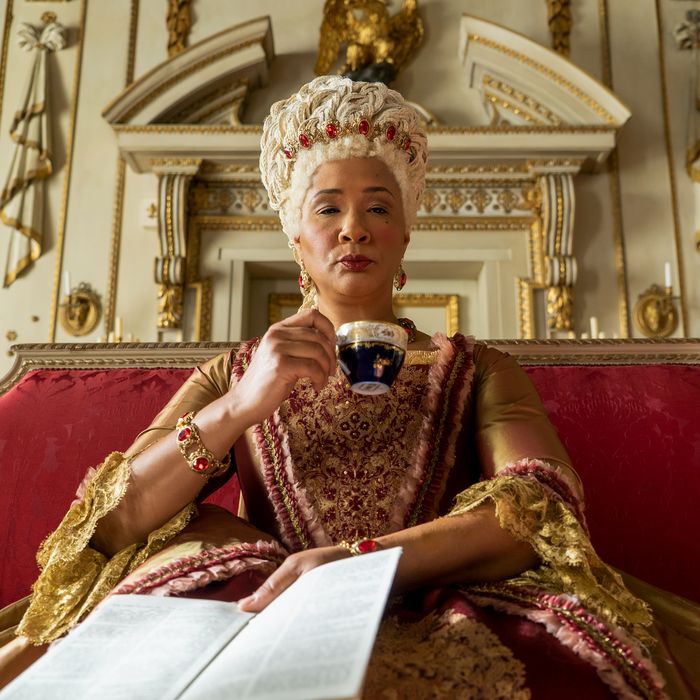
Shonda Rhimes’s new Netflix series Bridgerton has everything you’d want from a period drama: witty dialogue, smoldering glances, over-the-top costumes. Based on a series of romance novels by Julia Quinn, the show is set in England’s Regency era, which ran through the early 1800s and is famous for sumptuous fashions — think corsets, stockings, puffy sleeves, and heaving bosoms. It follows two opposing families, the Bridgertons and the Featheringtons, as they navigate romance, scandal, the rule of Queen Charlotte (Golda Rosheuvel, resplendent in pastel wigs), and the anonymous town gossip Lady Whistledown.
The show is lots of fun to watch, but its not-quite-historical approach does make you wonder: Did people really dress like this? Costume designer Ellen Mirojnick has been working in the industry since the 1970s (she’s responsible for the clothes in Fatal Attraction and Brandy’s 1997 version of Cinderella, among many others). She says she tackled this project the way she always does with historical work: first by looking at the period she’s working in, then amplifying it. The result is a funkier, louder, wilder version of the 1800s.
While Mirojnick’s designs employ historically accurate elements such as empire silhouettes and silk gloves, the details take the costumes above and beyond those of the Regency era. Her fictionalized vision of 1813 includes neon color schemes, larger-than-life wigs, thousands of Swarovski crystals, and hair accessories galore. The show is filled with lavish events like balls, parties, and even boxing matches, so Mirojnick had her hands full creating unique looks for the entire cast. She spoke to the Cut about corsets, tiaras, and the beauty of the bosom.
Photo: LIAM DANIEL/NETFLIX
When you started thinking about the Bridgerton costumes, what was your research process like?
I always begin with the actual time period that I’m working in, and then from there, I am tasked with interpreting the period. Our show is a fictionalized version of 1813 and the Regency era. I can’t emphasize fictionalized enough because that allowed me to really step out of the box and look at inspiration from many different areas. The single artist that was the inspiration for Bridgerton was an Irish painter named Genieve Figgis. I looked at her paintings and they just knocked me out.
Queen Charlotte was the actual queen of Great Britain and Ireland during this time. In real life, she always wore a corseted silhouette and a large hoop skirt. How did you make her looks into a statement on the screen?
Once she became Queen Charlotte in the 18th century, she never changed her silhouette and that was until the day she died. That was her signature. But we twisted her by giving her different hairstyles. I think that’s the fun of Queen Charlotte: changing her hairstyles, hair color, shape, everything, each time she changes her clothes. Collaborating with the hair department and the hair designer was a total trip because the designs that they would come up with, the wigs, they were just irresistible.
Speaking of hair, there were so many hair accessories: butterflies, flowers, feathers, diamonds! How did that come about?
It was a very organic choice. It was obvious because we were already working with so many flowers and crystals and butterflies. We did dresses and costumes that are encased in flowers. There were flowers wrapped in between organza. The natural extension was to move it to the top of the head.
There’s tons of diamonds throughout this series, from the necklace Daphne receives from the prince to Lady Danbury’s tiara to the intricate beading in the bodices. Where did all the sparkle come from?
Swarovski lent us tiaras from their archives, which we put on principle cast members. The amount of Swarovski stones used throughout the show was pretty massive. There were some fabrics that came pre-beaded and a lot of them did have Swarovski crystals, but it was always easy to add something. If there was a beaded fabric, we did more. If it was a stone headpiece, we built more. Nothing was left untouched.
Photo: LIAM DANIEL/NETFLIX
The Bridgertons and the Featheringtons are very different families. The Featheringtons are loud and bright, while the Bridgertons are a bit more refined. How did you accomplish that contrast through their costumes?
The Featheringtons’ signature are butterflies and the Bridgertons’ are bees. For example, at the first ball, Penelope Featherington wears her butterfly dress. The bodice of her dress is made into a butterfly that’s all decorated.
The Bridgertons are at the top of the social strata. They follow the rules, and they are very polished. Subsequently, they had a very pristine feel. It was clean, pretty, powdery. All of the colors that are used within that family are powdery.
The Featheringtons are new money and they aren’t educated in the same way. They want to make a statement and they want to be accepted. In the book, when Julia Quinn first talked about the Featheringtons, she described them as being tacky and ugly and citrusy and acidy and so on. When Chris Van Dusen created the series, that was translated. I didn’t think they were ugly; I thought they were fun. Dressing them was like decorating a cake. It was so sweet and so fun and so bold.
Photo: LIAM DANIEL/NETFLIX
Photo: LIAM DANIEL/NETFLIX
One of the most noticeable aspects of the Regency look is the heaving cleavage. What’s that all about?
It’s a corseted silhouette. It’s not a full corset, whereby the whole upper portion of your body is restrained. It’s a half corset so it comes to the top of your ribs. In every decade, there is a point of focus. In the Regency period, with an empire silhouette, the focus is the beauty of the bosom. I call it the mounds and the blossoming of the bosom. It’s just the prettiness of that shape. Everything moves up and focuses on the beauty of the bosom. It mimics the cheek, and it brings the roundness of the female form into focus.
Let’s block ads! (Why?)
See details here >>
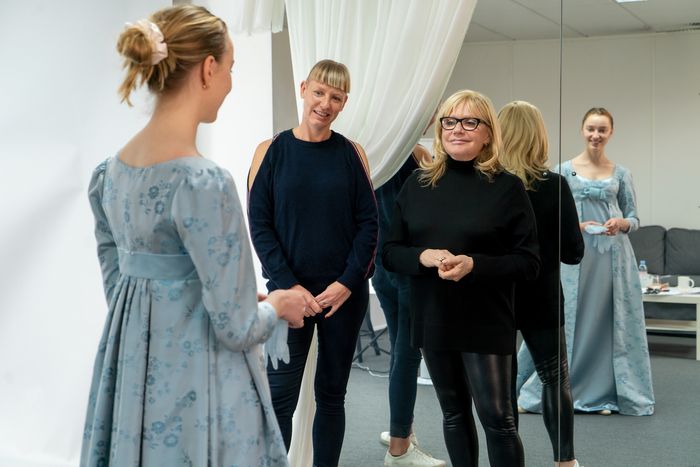
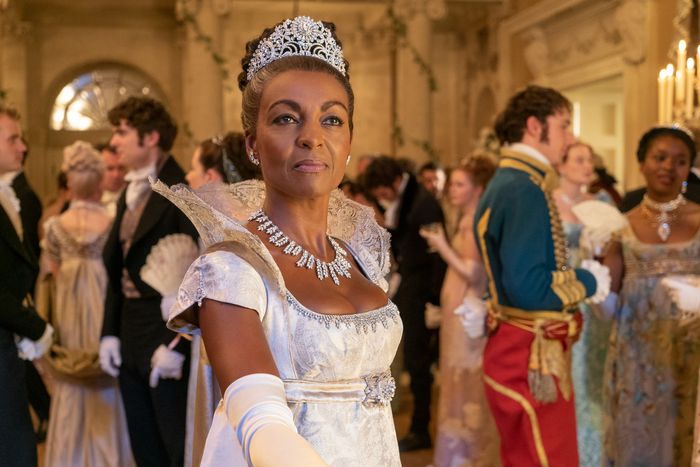
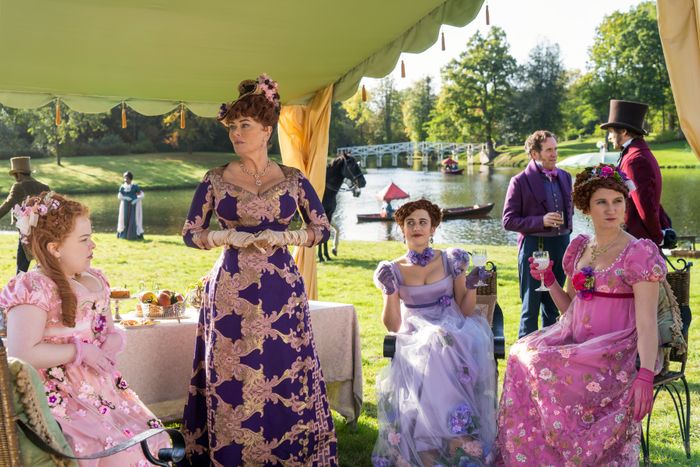
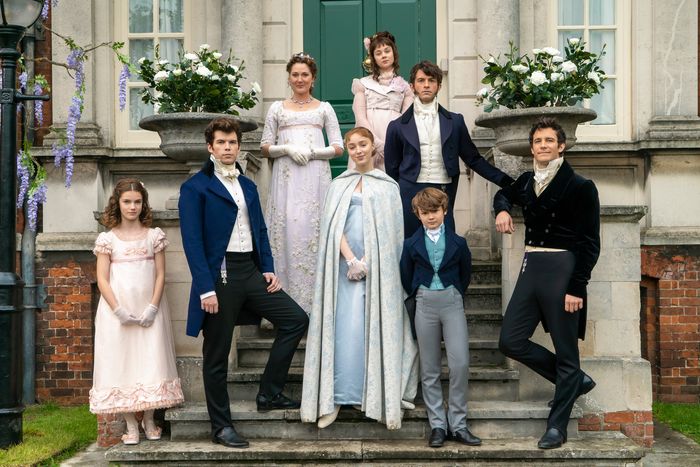




0 nhận xét:
Đăng nhận xét